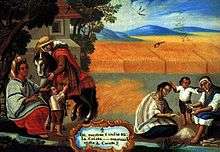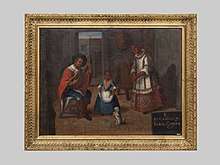Coyote (racial category)
Coyote (fem. Coyota), (from the Nahuatl word coyotl, coyote), is a derogatory colonial Spanish American racial term for a mixed-race person casta, usually referring to a person born of parents one of whom is a Mestizo (mixed Spanish + Indigenous) and the other indigenous (indio).

De Mestizo y de India; Coyote. Miguel Cabrera, 1763, oil on canvas, Waldo-Dentzel Art Center.

De mestizo e india, sale coiote. Anonymous 18th century. (From a Mestizo man and an Amerindian woman, a coyote is begotten).

De Castizo y India, Coyota. Anon. 18th c. Mexico
Representation
The casta paintings by Miguel Cabrera (1763) show the place of the coyote in the idealized colonial racial hierarchy (sistema de castas).[1] In colonial Mexico, the term varied regionally, with "regional differences determin[ing] just how much native ancestry qualified a person to be a coyote."[2]
- De Español e India, nace Mestizo
- De Español y Mestiza, nace Castizo
- De Castizo y Española, nace Española
- De Español y Negra, nace Mulata
- De Español y Mulata, nace Morisco
- De Español y Morisca, nace Albino
- De Español y Albina, nace Torna atrás
- De Indio y Negra, nace Lobo
- De Indio y Mestiza, nace Coyote
- De Lobo y Negra, nace Chino
- De Chino e India, nace Cambujo
- De Cambujo e India, nace Tente en el aire
- De Tente en el aire y Mulata, nace Albarazado
- De Albarazado e India, nace Barcino
- De Barcino y Cambuja, nace Calpamulato
- Indios Mecos bárbaros (Barbarian Meco Indians)
gollark: You can also publicly know who is participating if you monitor krist transactions.
gollark: Oh, seems fine then.
gollark: Or manipulate the timestamps by a few ms until it comes out right.
gollark: Then you could manipulate it.
gollark: Although I don't think the limited-time thing would work unless the hash function is *very* slow, and then the server would need to spend lots of time on it.
See also
References
- Katzew, Ilona. Casta Painting: Images of Race in Eighteenth-Century Mexico. New Haven: Yale University Press 2004.
- Vinson, Ben III. Before Mestizaje: The Frontiers of Race and Caste in Colonial Mexico. New York: Cambridge University Press 2018, p. 70.
Further reading
- Katzew, Ilona. Casta Painting: Images of Race in Eighteenth-Century Mexico. New Haven: Yale University Press 2004.
This article is issued from Wikipedia. The text is licensed under Creative Commons - Attribution - Sharealike. Additional terms may apply for the media files.